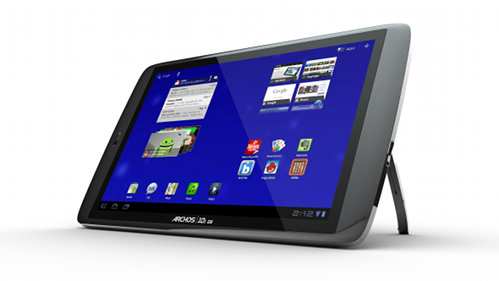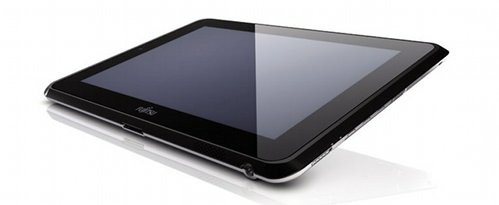Blog posts tagged slate
Two alternative ways to do tablet computing
It’s interesting to see how tablet computer manufacturers have lined up behind the indisputable industry leader, Apple. In some ways it feels like the iPad doesn’t have many head-on competitors.
Some tablet makers have tried to be a bit canny. Knowing Apple products aren’t cheap, they’ve aimed towards the budget end of the market – offering a tablet experience without the iPad’s price. Others have changed or added features – for instance, by making the display much smaller, including a detachable keyboard or adding an extra screen.
We’ve tested two tablets recently. The first is the Archos 101 G9. Available for a little over £200, this is a 10” tablet for the cost-conscious that fits squarely into the first category. The second we tried is the Fujitsu Stylistic Q550. At around £700 it ain’t cheap, but it’s one of the few tablets you’ll find running the full version of Windows 7.
Archos 101 G9: cheap but capable

The Archos 101 G9 is no iPad in looks or build quality. It’s made of fairly flimsy plastic and feels cheap. But when you’re paying half the price of an iPad, you have to tolerate the odd compromise. And although it might be plasticky, the Archos case has some nice touches.
The screen is responsive to touches and swipes, there’s a built in slot to add an optional 3G data card (to get online via a mobile phone network), and the convenient fold-out stand props the tablet up at the right angle to read or watch. It sounds like a small thing but it makes a real difference to this tablet’s usefulness.
Sure, the charging cable is far too short (would it have killed them to make it just a bit longer?), but the battery lasts well and the screen is fairly crisp, if lacking in contrast. Maybe most importantly, this tablet has reasonable power. With a proper dual-core processor, it runs the latest version of Google’s Android operating system, allowing you to access loads of different apps and they’ll run at a decent speed.
We did run into some quirks with the standard web browser. Tapping links didn’t always seem to register first time and there were a few stutters and judders that might put you off if you’re used to a smooth iPad.
In all, this is a capable tablet for the money. Although its features are geared more towards home than business users (Archos bill it as an ‘amazing multimedia’ machine for photos, videos and music), there’s no reason you can't use it for email, documents and more.
Fujitsu Stylistic Q550

Not to be confused with this Philadelphia soul group, and quite in contrast to the Archos, the Stylistic Q550 feels really solid. Fujitsu is clear that this tablet is for business users and has included a full-blown version of Windows 7, enabling you to run the exact same software as on any other Windows PC. That means no cut-down apps and no nightmares trying to view websites in an awkward mobile browser.
It also means the Fujitsu should easily integrate into your existing network without compromising security or compatibility. Further boosting its security credentials is built-in encryption and a fingerprint reader, although we’ve yet to come across anyone who actually uses the latter.
Other notable features include excellent connectivity (there’s USB, HDMI for an external display, an SD memory card slot and more), front and back cameras and a stylus, which is basically a pen you can ‘write’ on the bright, crisp screen with. This is attached to the tablet by a cord, but frustratingly there’s nowhere to tuck it when you’re not using it. It also requires an oddly-sized AAAA battery (no, that’s not a typo).
The stylus adds an interesting dimension. It’s fantastically helpful if you’re doing jobs that require pinpoint accuracy, like editing photos. But in other circumstances it doesn’t offer many advantages over your fingers. We can see how it’ll serve a niche market well. But for most people, the stylus will be superfluous.
More useful is wireless USB. Not yet available on many tablets, it lets you connect to compatible devices wirelessly. It’s ideal for giving presentations without having to plug anything in.
This tablet takes a while to start up but once it’s going performance is reasonable, especially as you’re running demanding Windows software. Strangely, there’s no sensor to rotate the display, so Fujitsu has included a button to do this manually. There’s also a button for classic Windows key combination ‘CTRL-ALT-DEL’, which hardly inspires confidence in the operating system’s stability.
Value for money trumps unnecessary features
It’s true these two tablets aren’t direct competitors, but while we warmed to the Archos for its excellent value for money, we found the Fujitsu harder to like. If you’re looking for a really portable Windows computer, you could add a dock, keyboard and display and it might do nicely. But as a tablet, it’s flawed: unless you really need the stylus or strong security tools, you’d be better off with an iPad.
Where to buy tablet computers |
More content on tablets:
HP TouchPad sale: is it worth buying an £89 tablet computer?
 Word has reached us (thanks PC Pro) that Dixons will slash the price of HP's TouchPad Tablet PCs from 6pm today. According to the company's Mark Webb, you'll be able to pick up the 16GB version of the tablet computer for £89. The larger 32GB version will cost £115.
Word has reached us (thanks PC Pro) that Dixons will slash the price of HP's TouchPad Tablet PCs from 6pm today. According to the company's Mark Webb, you'll be able to pick up the 16GB version of the tablet computer for £89. The larger 32GB version will cost £115.
Product discontinued
The reason for the huge reduction? HP announced last week that it's pulling out of the tablet computer business, triggering a fire sale in the US that now looks like it'll be mirrored over here.
With these products previously retailing for £400 or more, and competitors like the iPad 2 similarly expensive, this does look like a real bargain. But even if you can get on the Dixons site to buy one (we're predicting enormous demand for the limited supply), is it worth it?
Limited apps, sluggish performance
You'll be paying around £100 for a tablet PC with no real app 'ecosystem' (so there's not much you can install onto it). Still, you'll be able to browse websites, watch video and use maps. And that might be enough to persuade many people to part with the cash. We're seriously considering it.
But do be aware of the limitations if you're tempted. Going by this review you can expect sluggish performance compared to an iPad 2, limited (or non-existent) abilities to load and edit Microsoft Office documents, and a unit that's less-pleasing to hold than many of its competitors. There's another review here to help you make a snap decision.
The flip side
Despite these drawbacks, a bargain HP TouchPad might still be worthy of consideration if you want to dip a toe in the world of tablet computing. HP is promising to provide support for the tablet, and expects customers to continue to receive updates and enhancements.
Don't expect the TouchPad to match an iPad, In fact, to be safe, see it as a web browser that can play video and show you maps, and not much else. But even with those relatively low expectations, this is one £100 tablet that could be a bit of a bargain.
You should be able to buy online from 6pm today at Dixons, PC World and Currys. Good luck!
Sure, your iPad is cool. But my netbook is better for business.

Add a keyboard and perhaps your iPad will be more useful. (Photo: Stefan Evertz)
It's hard to deny that the iPad 2 is cool. And if you weren't one of the crazy enthusiastic punters who queued up last week to get one, demand for Apple's new gadget means that if you want one, you're probably in for a bit for of a wait.
Maybe we should all use that time to step back and ask: is the iPad actually much use for business? And, for that matter, do other tablet and slate-type devices like Motorola's Xoom or Samsung's Galaxy Tab really deserve a place in your company?
Limited business applications
I don't own an iPad, nor any other kind of slate or tablet computer. A few years back, I used Toshiba's M200 Tablet PC as my main work computer, but although it was one of the best laptops I've ever had, I rarely used the tablet features (you could fold the screen over and use a pen to write on it).
Sure, there's a big difference between Microsoft's clunky attempt to adapt Windows for a tablet device - which was running on that computer - and Apple's super-slick interface. But ease-of-use alone is not enough to establish the iPad as a must-have business tool.
The business applications I've seen for the iPad so far have been limited. I've spotted people at events using them to sign people up to mailing lists. And I can see how they'd be useful for people who need access to information but are on their feet all day. iPads could replace clipboards in warehouses, dentists' surgeries and the like.
My netbook is better and cheaper
But what about the sort of repetitive business tasks you take care of every day? Writing letters and emails. Running accounting software. Accessing your customer relationship management system.
For these sorts of jobs, my distinctly un-glamorous netbook (a cheap, cut-down laptop) is far better than an iPad. Here's why:
- It's not as small or as light as an iPad, but it's small and light enough to go everywhere with me.
- It has a proper keyboard, so I can type documents accurately and quickly.
- It has USB ports and doesn't need extra adaptors to plug into a proper monitor, so it's easier to use with my existing IT kit.
- The battery lasts about eight hours. That's probably less than an iPad, but plenty for a day on the road.
- There's plenty of space for my files and I can switch from web browser to spreadsheet to whatever in seconds.
In fact, the more I think about it, the more it seems that the only advantage that slate devices offer is that you can use them standing up. If there's a desk or space where I can sit and type at my netbook, it's the better option. Although, to be fair, I won't look as cool.
What's more, a netbook like mine is cheap. Figure £250 or so for a very capable netbook, compared to £399 for the entry level iPad.
Is it just me who can't see the point of the iPad for businesses? Do you use one in your company? Leave a comment and let me know.



